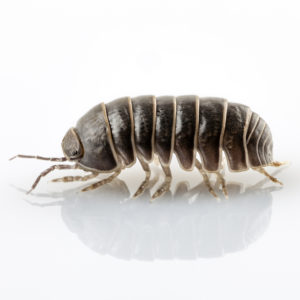 INTRODUCTION: Pillbugs are sometimes called “roly-polies” and get this common name because they roll up into a tight ball when disturbed. These land-dwelling crustaceara are arthropods but not insects.
INTRODUCTION: Pillbugs are sometimes called “roly-polies” and get this common name because they roll up into a tight ball when disturbed. These land-dwelling crustaceara are arthropods but not insects.
RECOGNITION: Adults about 1/4-5/8″ (7-15 mm) long, convex above but flat or hollow beneath. Color slate gray.
BIOLOGY: The eggs are deposited and hatch within the brood pouch or marsupium on the underneath side of the body. It usually takes about 45 days for the eggs to develop, hatch, and the young pillbugs to emerge from the pouch. The number of young per brood averages about 28 (range 5-79) and there are 1-3 broods per year. Within 24 hours of leaving the pouch the young molt, again at 14-18 days, and then irregularly thereafter depending on food availability. Adults may live about 2 years, possibly longer. Pillbugs are confined to areas of high moisture because they lack both a closing device for their respiratory system and an outer waxy layer on the exoskeleton to prevent excessive water loss. Their nocturnal habit also reduces water loss.
HABITS: Pillbugs are inactive and remain hidden under objects during the day to reduce water loss. During the day, they can be found around buildings in such places as under trash, boards, rocks, flower pots, piles of grass clippings, flower-bed mulches, and other decaying vegetation. They occasionally enter buildings via door thresholds, especially homes with sliding-glass doors on the ground level. Indoor invasion typically means that there is a large population immediately outside the building. They usually do not survive indoors for more than a couple of days unless there are high moisture conditions and a food supply present. Pillbugs are scavengers and feed on decaying organic matter, usually plant material but occasionally animal. They cause no damage and are considered a nuisance pest indoors. Outdoors, they occasionally injure young plants.
CONTROL: The key to controlling pillbugs is to reduce or eliminate the moist areas which make their survival possible. For example, remove piles of grass clippings and leaves, store boxes, lumber, firewood, and flower pots off the ground, and provide adequate ventilation in crawl spaces. Indoors, they can be removed with a vacuum. Application of appropriately labeled residuals can be made to building foundation walls, perimeter flower and/or ornamental plant beds, unfinished basements, and crawl spaces. Wettable powder and microencapsulated formulations are best, but dusts are also good in drier crawl spaces.
